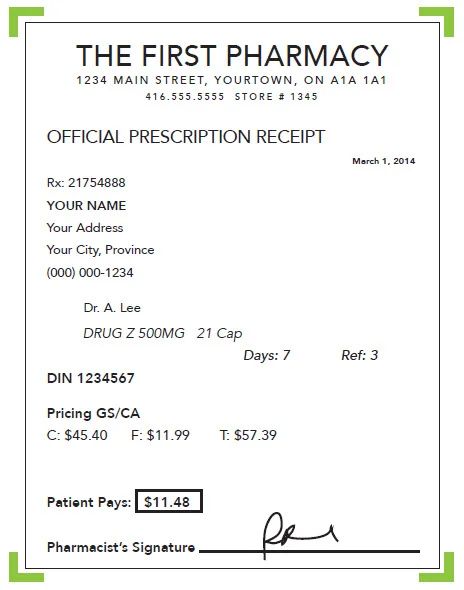Understanding Prescription Drug Receipts
Ever wonder what the information on your pharmacy prescription drug receipt means or how you can have an impact on your prescription costs?
Decoding your receipt
There are a few different codes and charges listed on a prescription receipt, and it’s not always easy to figure out what they all mean. The sample receipt below represents a typical pharmacy prescription receipt for a plan member covered under an RBC Insurance drug plan.
Some of the information on the receipt is self-explanatory–such as the pharmacy details, the prescriber’s name (doctor), and the name of the drug. Decoding the acronyms can be tricky though. Here are some of the terms explained:
- DIN: Refers to the Drug Identification Number. This number uniquely identifies all drug products in Canada.
- Pricing GS/CA: Refers to Green Shield Canada, the drug claims adjudicator for RBC Insurance. In the example below, a portion of the prescription drug cost was submitted to the claims adjudicator.
- C: Refers to the ingredient portion of the prescription cost. The cost includes the manufacturer’s price, the wholesaler’s mark–up and the pharmacy’s mark-up–which can vary from pharmacy to pharmacy.
- F: Refers to the dispensing fee or professional fee. This is the fee the pharmacy charges to dispense the drug, and varies from pharmacy to pharmacy.
- T: This is the total cost charged for the prescription.
- Patient Pays: This is the amount that the patient is required to pay, based on his or her drug plan coverage. In the sample receipt, the drug plan paid 80% of the total cost, and the plan member paid the remaining (20% X $57.39 = $11.48).

By asking your doctor to prescribe a generic drug instead of the brand version which costs more, and by choosing a pharmacy that offers lower dispensing fees, you can help to reduce costs not covered by your group health plan.


